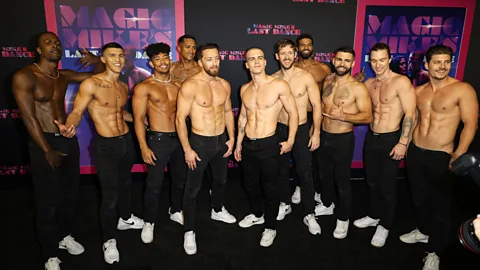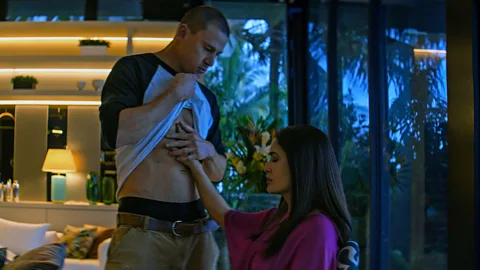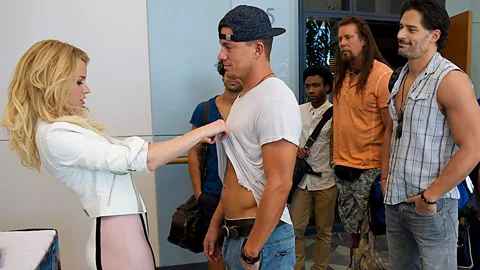Magic Mike and the new age of the male stripper
 Alamy
AlamyWith the third film, Magic Mike's Last Dance, out now, Anna Bogutskaya reflects on how the Channing Tatum franchise has changed the perception of men taking their clothes off.
One does come to a Magic Mike film for the plot. Until recently, the world of male stripping was not perceived as an aspirational one, or a particularly deep one. Male strip shows may have been popular a choice of entertainment among hen parties et al, but the male stripper was seen as a laughable figure within popular culture – you only have to think of hit British film The Full Monty (1997), whose humour rested on the fact that a group of ordinary steelworkers were "reduced" to taking their clothes off as a result of being in dire financial straits.
More like this:
– Magic Mike's Last Dance review
Nowadays, though, the profession has gone through a complete image overhaul – and that's all thanks to Magic Mike. The multi-pronged franchise, which comprises multiple films, live shows around the world, and an HBO talent show, has single-handedly given the male revue a glossy new allure: last week, the third and supposedly final movie, Magic Mike's Last Dance hit cinemas.
 Alamy
AlamyAt the same time as the Magic Mike Extended Universe has boomed, there's been a notable interest in exploring the darker side of the profession too, with 2021 blockbuster podcast Welcome to Your Fantasy recounting the true crime origin story behind the Chippendales, the first US all-male stripping troupe, founded in 1979, who became a national success catering mostly to female audiences. Since that podcast, the story has also been revisited in a four-part documentary Curse of the Chippendales and given the high-budget glossy fictional treatment with last year's Hulu series Welcome to Chippendales, starring Kumail Nanjiani and Murray Bartlett.
However even though the Chippendales are still performing to millions of people every year, it's Magic Mike that's become eponymous with the modern male stripper – who typically prefers to call themselves a "male entertainer" these days. The Magic Mike brand promotes female empowerment via hot men and a good night out. And at the centre of it is Channing Tatum, a dancer, actor and producer who has elevated the cinematic beefcake into an art form and morphed from the star of the films into the architect of the whole global Magic Mike brand. But what is the cultural footprint of the Magic Mike Industrial Complex? Is the franchise's appeal as simple as hot dudes dancing or is it in fact something more profound, a conduit for a positive brand of masculinity?
Dr Bernadette Barton, sociology and gender studies professor at Morehead State University and author of Stripped: Inside the Lives of Exotic Dancers, says its appeal really lies in the fact that it's "still very novel for us to see male bodies be portrayed as objects of desire". There's also more leeway for male stripping to be celebrated in popular culture, she believes: "there's less at stake with male strippers. There's less violence, less assault. Not that female customers can't be handsy or obnoxious but there isn't the same amount."
Not that the first Magic Mike film is exactly carefree. It was inspired, famously, by Tatum's own background as a $50-a-night stripper – a detail that was revealed to the world against his will when a strip club owner named London Steele, (yes, really), the man who had hired him way back in his stripper days, sold a video of Tatum (then working under the moniker of Chan Crawford) to US Weekly in 2009. That was the year that Tatum's star was ascending, with starring roles in Dito Montiel's Fighting and GI Joe: The Rise of Cobra. Instead of feeling embarrassed, or denying it, Tatum made a movie about it. The origin story for the film stretches back to a casual beer Tatum had with Steven Soderbergh after making their first project together, Haywire (2011), when he told him about the nine months he spent as a stripper. Game recognises game, and Soderbergh encouraged Tatum that it would make a great movie. When asked during a Haywire screening Q&A what film would bring him out of his self-imposed, impermanent retirement, Soderbergh replied: "Channing Tatum's stripper story". The rest happened in a whirlwind: the script had to be ready to take to market at the Cannes Film Festival in May 2011 and Soderbergh had a small window in August to shoot it. It ended up grossing $167 million worldwide and creating the base for what would become Tatum's emporium.
"When we went to make the movie, we were making Boogie Nights or Saturday Night Fever; we didn't really understand that we were making a movie for women," said Reid Carolin, screenwriter of the Magic Mike trilogy, Tatum's producing partner and his co-director on Dog (2022), to The Ringer last year. As well as making serious money at the box office, it caused a furore amongst audiences. Straight women and gay men packed theatres. The audience was reported to be 73% women. The distributor promoted the release at gay pride events around the US and hired dedicated agencies to target and build buzz in gay bars and clubs. Some cinemas even hired go-go boys to celebrate opening night. I went to see it twice at the cinema, which was both times packed and vibrating with an excitement reserved for illicit activities.
A capitalist parable
Whilst the dances and the neatly packaged, somewhat retconned Magic Mike ethos of empowering female desire have become the global brand's USP, the first film is actually less concerned with either of these things than it is with the death of the American Dream. Magic Mike is not really a film about male strippers, it's about financial precarity. When we meet "Magic" Mike Lane (Tatum), he's working multiple jobs – stripping being one of them. (Tatum, too, worked many odd jobs before breaking out as a dancer and actor, including construction, sales at a mortgage company, and "cleaning cages at a puppy-kitty nursery.")
 Alamy
AlamyThe narrative thrust of Magic Mike is Mike's desire to leave the stripping behind to start up his own business, and, in doing so, stop working for someone else and work for himself instead. In the film, he calls himself "an entrepreneur", but really what he is is a freelancer in the middle of a recession. Mike's long-term goal is to open his own furniture-building business. His sunny, beachfront Tampa apartment is full of vintage furniture – I spotted two Mies van der Rohe and Lilly Reich Barcelona chairs, which cost anywhere from $4,000 to $60,000 – and of his own creations – a chair, a coffee table with industrial touches – that he built himself. Perhaps the least memorable but most crucial scene of the film is Mike visiting a bank to request a loan: he's got his briefcase, his documents all in order, his deposit of $13,000 in hard-earned singles and is on the charm offensive. In the bank, he's performing acceptability by cosplaying as a "serious business-man", almost comically so, with his rim-framed glasses and beige suit. Despite his best efforts and hard cash, Mike can't get a loan.
Like many of Soderbergh's films, Magic Mike is concerned with transactional relationships. Or, as David Edelstein put it in his original Vulture review, "how capitalism transforms sex into a soulless commodity". Dallas (Matthew McConaughey), Mike's mentor and boss, perhaps best embodies this: he is a hardcore capitalist, a self-proclaimed "messiah of the male revue", loyal only to the dollar. During his solo dance routine, he is positively orgasmic when he is covered in dollar bills: as Edelstein puts it, he is "the whore as master of the universe", a universe he built himself.
He not only owns the club, he effectively owns the men who are dancing for him and, most crucially, he owns the dream. His relationship with Mike is a faux mentorship, with Dallas keeping Mike in place by dangling the promise of an equity stake in the grand, 4,000-sq-ft Miami club that he's planning to open. Magic Mike is one example of a contemporary subgenre that elucidates on sex work and economics. In Hustlers (2019), working class women rob white-collar finance bros, who rob all of us. The Girlfriend Experience (2009), also directed by Soderbergh and starring real-life porn star Sasha Grey, explored the world of a sex worker whose income (and that of her high net-worth clients) was being affected by the global economic crisis. The anthology drama series of the same name, co-created by indie filmmakers Lodge Kerrigan and Amy Seimetz, expanded on the idea of intimacy as currency, with a first season starring Riley Keough as a law student turned successful escort.
These films and shows, like the first Magic Mike, are cold-hearted and slick, visually rooted in the aesthetics of sleaze. When Mike quits stripping, it's because of the betrayal of Dallas offering equity to the younger, inexperienced and rash Kid (Alex Pettyfer), who Mike has brought into the club as fresh dancing meat. Dallas doesn't bat an eyelash before moving onto the Kid as another young, hot property to exploit. Shane Ferro, talking about the film in a 2021 episode of the Slate Money podcast, points out how equity in the Miami club is just a "bargaining chip to keep people at each other's throats and keep them competing with each other so that they’re not actually competing with capital". It was capitalism all along!
The franchise's evolution
Alongside the intended commentary, however, Magic Mike unknowingly tapped into a vast chasm of female desire and voyeurism. In the cinema, women were allowed to look, howl and thirst as much as they wanted – and once the filmmakers realised who was going to see the film and why, they decided to lean into this. So it was the Magic Mike universe evolved from an anti-capitalist commentary into a bona-fide erotic celebration. In the sequel, Magic Mike XXL (2014), Mike – without the Magic – now owns a custom furniture-making company, like he always dreamed. He has an employee and a truck. He's dodging the calls of his former dance-mates. His siren song back into the male entertainment world is Pony, R&B singer Ginuwine's uptempo 1996 sex jam about a "man trying to find his partner"; randomly hearing it on the radio leads Mike into an unforgettable sequence of grinding and drill-humping in his carpentry workshop. That in turn inspires him to get back together with the Kings of Tampa for one last ride (pun intended) to a stripping convention.
One of the understated elements of the first film was the camaraderie and ive dynamic between the dancers (with the exception of the Kid, who was a wrong'un to begin with) – and the second film develops that further, making them even more endearing. Despite their hyper-masculine appearance, the men of Magic Mike XXL are not insecure about their masculinity or locked into an idea of manhood that's code for misogyny. In all their scenes together, they are at ease with themselves and each other. As is made clear, the performative macho routines and cliched characters like sexy fireman and policeman they had been assigned by Dallas (who, at this point, is out of the picture, having moved to Macau with the Kid to start a new show) are stale and ill-fitting to their personalities – and so in the film's narratively minimal but hugely satisfying finale, each Tampa King finds their true "Pony": Tarzan is a (dirty) painter; Rico has a sweet-shop routine set to Candy Shop; Ken sings a romantic ballad into a sea of women; and the aptly-nicknamed Big Dick Richie consummates a marriage in a sex swing to the tune of Closer.
 Alamy
AlamyIn one sense, the film is about stripping as work. Theirs is a performance that demands skill and preparation, not just an athletic physique. It's not enough to look generically hot; it is physically and psychologically demanding. Crucially, however, the sequel throws away any capitalistic dream of a big payday and instead focuses on desire. Specifically, female desire. The dancers' success is chiefly represented not by the amount of bills stuffed in their thongs, but by the satisfaction of their audience. While Mike and the Kings of Tampa are the leads, the film is actually all about horny women – "a demographic often neglected and therefore willing to pay whatever it costs to be treated well," as Molly Lambert wrote in a feature for Grantland about male stripping published around its release. Magic Mike XXL identified its audience, and then superserved them. "On paper, it shouldn't have worked," says writer and actress Isaura Barbé-Brown, "It was so well-judged without feeling like it was pushing an agenda."
On their road trip, they encounter different women to help them discover the reason they do the male entertaining to begin with. Whether it's the grin on a gas station attendant's face after an impromptu performance by one of the crew or the full-bodied ecstasy of the woman being oiled down in the fantastical, male entertainer-filled Club Domina that they make a stop at, the women of Magic Mike XXL are ecstatic with glee. "There are women of all shades, shapes and sizes," observes Barbé-Brown. Their needs are identified and serviced by the dancers, be that by serenading, air-grinding or some unnameable hip acrobatics.
Going live
Bringing the spirit of Club Domina into the real world, Magic Mike Live first launched in Las Vegas in April 2017, before arriving in London's West End in November 2018. Since then, it has played in Berlin and toured the US and Australia. When the tickets for the UK production launched, it melted down Ticketmaster, trended on Twitter and grossed over £1 million in just 24 hours. The appetite for hot men dancing was global. The first time Barbé-Brown went to see the show, nobody could tell her exactly what it was, "they just told me it was amazing," she says. "I've never seen anything else like it, that's been so specifically tailored to women. It feels very safe despite the fact that there are shirtless men running around grinding on people."
Natazca Boon, who plays the female MC that guides the London show, tells me this feeling is completely designed from inception: "For Channing it was very important that his creative team was very heavily female; that would guide him to create this universe that feels good to watch." Magic Mike's choreographer and the show's co-director is Alison Faulk, a long-term collaborator of Tatum's. Nothing can quite prepare you for what's going to happen at a Magic Mike show. The stage incarnation is an extraordinary choreography of bodies, acrobatics, lights and screams. It's impossible to take everything in one go. In a regular show, there's the stage and the audience. In Magic Mike Live, there's the stage, ladder, balconies, plexiglass, bridges, acrobatics, water and an aerial number. The audience can take pictures and video of everything and anything, unusual for a West End show. Boon's warm, constant interaction with the audience ushers things along and provides cues for the dancers, who, at certain key points, jump off the stage and into the audience, selecting women to dance with (or on) before moving on to the next. "The word 'strip' never gets spoken in the whole show," Boon points out. The only, unspoken, rule is that only women wearing tros can be taken on stage – and that's only to save anyone any embarrassment when they're being lifted up and delicately thrown around by the dancers. The Prosecco flows. The delighted shrieks are deafening. The day after seeing Magic Mike Live on the West End, I find a bright red unicorn dollar stuck inside my pocket; it's the fake money given to attendees to throw at the performers.
As for the dancers, they are, first and foremost, expert performers but have also been selected to fit a sexy-but-sensitive mould. As Jack Manley, one of the original London dancers, tells BBC Culture, after much cajoling from his friends ("How much do you have to love yourself to go to a Magic Mike audition">window._taboola = window._taboola || []; _taboola.push({ mode: 'alternating-thumbnails-a', container: 'taboola-below-article', placement: 'Below Article', target_type: 'mix' });
